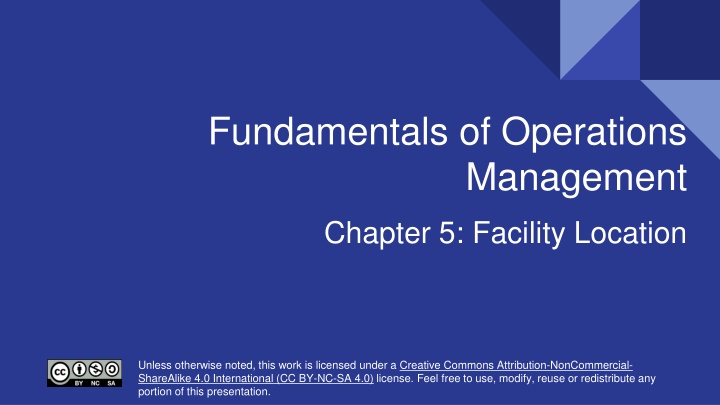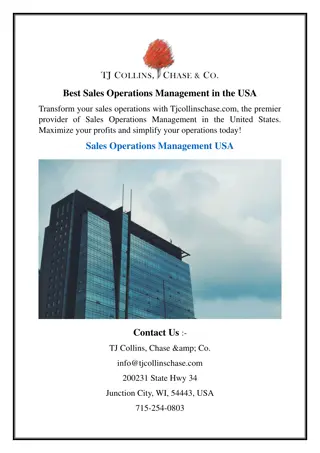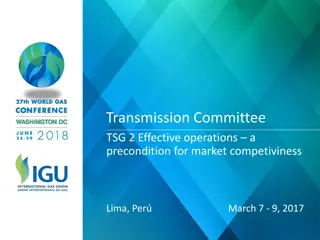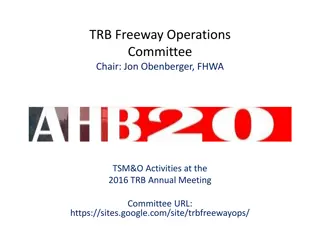
Facility Location Decisions: Strategic Importance and Key Factors
Explore the strategic significance of facility location decisions in operations management, including factors influencing choices, such as proximity to resources, labor considerations, and transportation infrastructure. Learn how to evaluate potential locations using quantitative methods and develop a comprehensive location strategy aligning with organizational objectives.
Download Presentation

Please find below an Image/Link to download the presentation.
The content on the website is provided AS IS for your information and personal use only. It may not be sold, licensed, or shared on other websites without obtaining consent from the author. If you encounter any issues during the download, it is possible that the publisher has removed the file from their server.
You are allowed to download the files provided on this website for personal or commercial use, subject to the condition that they are used lawfully. All files are the property of their respective owners.
The content on the website is provided AS IS for your information and personal use only. It may not be sold, licensed, or shared on other websites without obtaining consent from the author.
E N D
Presentation Transcript
Fundamentals of Operations Management Chapter 5: Facility Location Creative Commons Attribution-NonCommercial-ShareAlike 4.0 International (CC BY-NC-SA 4.0) Creative Commons Attribution-NonCommercial-ShareAlike 4.0 International (CC BY-NC-SA 4.0) Unless otherwise noted, this work is licensed under a Creative Commons Attribution-NonCommercial- ShareAlike 4.0 International (CC BY-NC-SA 4.0) license. Feel free to use, modify, reuse or redistribute any portion of this presentation.
5.0 Learning Outcomes In this chapter, we will: Explain the strategic importance of facility location decisions and their long-term implications on an organization's profitability and competitiveness. Analyze the key factors influencing facility location decisions, including proximity to raw materials, labour considerations, transportation infrastructure, utility costs, tax incentives, customer proximity, and community factors. Differentiate the location decision factors for manufacturing and service organizations, recognizing each industry's unique priorities and considerations. Apply quantitative methods, such as the Location Factor Rating (Weighted Scoring Model) and the Centre of Gravity method, to evaluate and compare potential facility locations based on specific operational requirements and strategic objectives. Assess the impact of e-commerce and web-based retail industries on facility location decisions, particularly for service-oriented companies. Develop a comprehensive facility location strategy that aligns with the organization's objectives, optimizes operational efficiency, minimizes costs, and enhances responsiveness to customer demands.
5.1 Location Strategy: A Critical Decision Crucial Strategic Decision Geographic location of operations is a key strategic choice across all sectors. Long-term Implications Location decisions have lasting effects on profitability. Substantial Capital Investment Significant portion of operating costs tied to location. High Operating Costs in Retail Location expenses can exceed 40% of total costs. Service vs. Manufacturing Service businesses need proximity to customers; manufacturers prioritize raw materials and labor. Industry Nature and Product Type Location influenced by whether the business is in manufacturing or services.
5.1 Factors and Trends in Location Decisions Service Industry Adaptations: Banks and retailers moving services online to cut costs. Rise of E-Commerce: Online services reduce dependence on physical locations. Manufacturing Needs: Production facilities must consider raw material access and labor. Location Impact on Performance: Location decisions affect overall performance and market responsiveness. Cost and Responsiveness: Optimal location minimizes costs and maximizes market responsiveness. Prioritizing Factors: The importance of factors varies by situation and industry type.
5.2 Key Factors in Location Decision-Making Facilities locate near raw material sources to minimize transportation costs, e.g., paper mills near forests. Location decisions are influenced by wage rates, workforce availability, education levels, and union activity. Efficient roads, railways, and ports are essential for distributing finished goods cost- effectively. Proximity to Raw Materials and Suppliers Transportation Infrastructure Labour The cost and reliability of utilities impact a facility's operating expenses. Tax incentives and regulatory environments affect the financial viability of a location. Being near customers is crucial for service firms and industries with high transport costs or perishable products. Communities attract businesses with incentives and favorable attitudes towards specific industries. Utility and Energy Costs Tax Incentives and Regulations Proximity to Customer Market Community Factors
5.3 Location Factor Rating Method Identify Key Factors: Determine crucial factors for the facility location decision, such as proximity to suppliers, business environment, wage rates, community characteristics, proximity to customers, availability of labour, and transportation access. Assign Weights: Assign a weight (0 to 1.0) to each factor, reflecting its importance. Ensure the total sum of weights equals 1.0. Score Locations: Evaluate each potential site against each factor and assign a score (0 to 100), with higher scores indicating better performance. Calculate Weighted Scores: Multiply each factor's score by its weight for each location to obtain weighted scores. Determine Optimal Location: Sum the weighted scores for each location; the site with the highest total score is the most attractive.
5.3 Break-Even Method Compare Production Costs Graphical Representatio n Forecasted Demand Break-Even Analysis Total Cost Formulation Evaluate fixed (land, building, rent) and variable costs (labour, material, utilities) across multiple locations. Ensure all locations can meet the forecasted market demand, either as a single quantity or a range. Use break- even analysis to compare production costs or projected profits for each location. Formulate total costs for each location using simple linear equations. Depict total costs graphically or use Excel to visualize and compare costs across locations.
5.3 Centre of Gravity Method This method minimizes transportation costs by determining the optimal facility location (e.g., warehouse) using an (X-Y) coordinate system based on the geographical locations and demand volumes of multiple areas. Mathematical Formulation: Calculate the x and y coordinates for the new facility using the formulas: Figure 5.3.1: Three market areas on an X-Y coordinate axis.
5.4 Strategic Significance of Location Decisions Facility location is a critical strategic decision with significant financial implications in today s competitive business environment, impacting manufacturing and service sectors. No single factor dictates facility location decisions; prioritization depends on organizational objectives, whether focused on cost minimization or profit maximization. The importance of location factors varies across industries, operational needs, and strategic goals, necessitating a tailored evaluation process. Effective decisions integrate a holistic assessment of factors aligned with long-term organizational goals and competitive positioning. Prioritizing relevant factors enables organizations to optimize facility locations, enhancing operational efficiency and responsiveness to customer needs. This chapter offers a comprehensive framework for operations managers to navigate facility location complexities, empowering strategic decision-making that drives organizational success.
Summary & Review The chapter underscores the strategic importance of selecting the right geographical location for organizational operations, impacting profitability and competitiveness significantly. Key factors influencing location decisions include proximity to raw materials, labour availability, transportation infrastructure, utility costs, tax incentives, and proximity to customer markets. It acknowledges the evolving impact of e-commerce, noting varying dependencies on physical locations between service-oriented and manufacturing firms. Quantitative methods such as the Location Factor Rating and Centre of Gravity are presented to aid in informed location decisions, focusing on weighted factor evaluation and minimizing transportation costs, respectively. Effective facility location decisions necessitate a comprehensive evaluation aligned with strategic objectives, enhancing operational efficiency, cost-effectiveness, and market responsiveness. By systematically prioritizing these factors, organizations can attain a competitive advantage through optimal facility location choices.



















